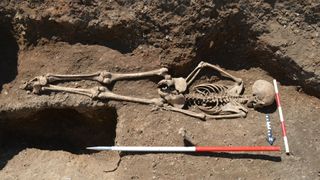Medieval girl buried face down with bound ankles, likely so she couldn't 'return' from the grave
The medieval remains of a 15-year-old girl reveal that she was buried face down and with bound ankles at the edge of a settlement.

Before abandoning their settlement, a medieval community in England tore down an elaborate entrance gate and buried a 15-year-old girl in its place. And in a final act marking her as different, they likely bound her ankles and interred her face down, a new analysis reveals.
The girl's unusual burial on the boundary of the settlement is an expression of "otherness," archaeologists noted.
"We will probably never know exactly how this young woman was viewed by the community she grew up in, but the way she was buried tells us she was almost certainly seen as different," Don Walker, a senior human osteologist (bone specialist) at the Museum of London Archaeology (MOLA), said in a statement released Monday (Aug. 14). "Her burial rites may have reflected the nature of her death, or her social identity or that of her family."

It's even possible that the community bound the girl's ankles due to a belief that her corpse might rise from the grave and harm the living.
"As well as being buried face down on a boundary, the position of her ankles suggests they may have been tied together," Walker noted. "This implies that the community took extra measures to ensure she could not 'return' from the grave."
Related: 400-year-old 'vampire child' found buried with its foot padlocked to stop it rising from the grave
The girl's remains, which were buried between A.D. 680 and 880 near the village of Conington in Cambridgeshire, show she experienced many hardships during her short life: Her teeth carry evidence of malnutrition, and her back reveals she had a spinal joint disease that was exacerbated by hard manual labor.
Sign up for the Live Science daily newsletter now
Get the world’s most fascinating discoveries delivered straight to your inbox.
These clues suggest the teenager had a low social status. Her skeleton doesn't have signs of long-lasting illness, so it's possible the girl died in a sudden or unexpected way, archaeologists said in the statement.
Archaeologists unearthed the girl's remains between 2016 and 2018, during excavation work ahead of a construction project. Now, scientists at MOLA Headland Infrastructure have studied the teenager's skeleton and burial site in more detail.
The girl's face-down position is unusual, as most deceased people in early medieval England were buried face up.

Archaeologists had previously found another face-down burial from early medieval England. About 30 miles (50 kilometers) away at Higham Ferrers, Northamptonshire, a woman buried in the late eighth or early ninth century was interred face-down in a ditch at the edge of the settlement. This woman was buried without her arms, head, neck and fourth lumbar, indicating that she was an execution victim.
It's possible that medieval face-down burials were purposefully located at a settlement's border or boundary, the archaeologists said. They noted that when the teenager's community pulled out a large wooden post at the settlement's entrance, the leftover pit may have conveniently provided a ready-made grave.
The girl died between the late seventh and late ninth centuries, radiocarbon dating revealed, whereas activity at the settlement dates to the eighth and ninth centuries. The settlement served as one of the administrative centers for Mercia, a powerful kingdom in Anglo-Saxon England. But when the kingdom began to lose power, the settlement was abandoned.
If the girl's burial coincided with the settlement's abandonment — as the removal of the gate post that serves as her burial spot suggests — it's likely one of the last things her community did before moving on.

Laura is the archaeology and Life's Little Mysteries editor at Live Science. She also reports on general science, including paleontology. Her work has appeared in The New York Times, Scholastic, Popular Science and Spectrum, a site on autism research. She has won multiple awards from the Society of Professional Journalists and the Washington Newspaper Publishers Association for her reporting at a weekly newspaper near Seattle. Laura holds a bachelor's degree in English literature and psychology from Washington University in St. Louis and a master's degree in science writing from NYU.
